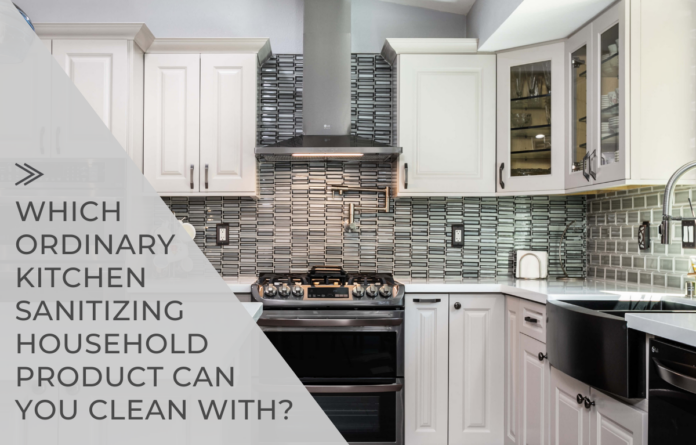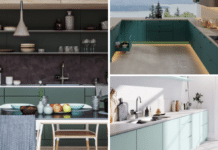In today’s climate, we’ve been warned to constantly sanitize surfaces to prevent the spread of COVID-19. However, several disinfectant wipes and sprays are constantly out of stock because the demand is so high.
However, are there alternatives that we have among our everyday kitchen sanitizing household products that we can use to clean and keep ourselves safe?
We examine different household items and see how potentially effective they are in sanitizing our surfaces based on their disinfecting properties specifically related to COVID-19.
Let’s take a look at what the CDC (Center for Disease Control) recommends for sanitizing protection:
“Handwashing mechanically removes pathogens, while laboratory data demonstrate that 60% ethanol and 70% isopropanol, the active ingredients in CDC-recommended alcohol-based hand sanitizers, inactivates viruses that are genetically related to, and with similar physical properties as, the 2019-nCoV.”
– CDC March 14, 2020
Kitchen Sanitizing Household Product Options
The CDC also has a list of methods to prevent the spreading of infection. Some of these will be addressed here:
Rubbing Alcohol

We are starting with rubbing alcohol because this is the common name of “isopropanol,” also called “isopropyl alcohol.”
So we absolutely know this works. Rubbing alcohol solution can be put into a spray bottle with 1 part rubbing alcohol and 1 part water.
Can this kitchen sanitizing household product be used on flat surfaces? There are two options:
- Spray rubbing alcohol solution on the surface and wipe down with a paper towel or soft cloth
- Pour a small amount directly into a cloth and wipe down.

This is effective on cleaning plastic and stainless steel surfaces where the infection droplets can last three days.
To create your own hand sanitizer, 2 parts or 3 parts rubbing alcohol can be mixed with 1 part aloe vera. Lemon juice, peppermint oil, or lavender oil can be added to reduce the harshness of the alcohol scent.
Using rubbing alcohol directly on skin will disinfect it, but it will dry the skin. Repeated use will irritate and crack it, so direct daily use is not recommended.
To disinfect items like phones, Rub alcohol on them the same way you would a flat surface. This also cleans screens nicely.
Bleach

According to the CDC, bleach solutions are also effective, as long as they work with the surface. They stress that the bleach should not be expired and especially should not be mixed with other cleansers. Bleach is a strong chemical and 5 teaspoons can be mixed with 1 gallon of water to creative an effective cleaning agent.
Warning: Bleach should NOT be mixed with ammonia since that produces chlorine gas which is hazardous. This can irritate the eyes, skin or have more harmful effects. Bleach can also stain clothing and should be used with caution.
On flat surfaces – Bleach solutions are effective on nonporous surfaces like sinks, countertops, tiles, and flooring.
Bleach should not be used on porous surfaces like wood and granite countertops. It is not recommended using bleach on stainless steel because it corrodes the steel, even though it will disinfect it.
As hand sanitizer – Bleach has a pH of 11, which is a very strong base and can be toxic. Gloves are always recommended when handling bleach. Bleach should not be used to clean your phone or any tech item.
Soap

We are constantly told to wash our hands with soap for at least 20 seconds to prevent the spread of infection. This is for a good reason; soap is a destroyer of the COVID-19 virus. Most people are concerned about sanitizer and chemical disinfectants when soap is more commonplace and does the job.
There’s a reason why soap is so effective against the COVID-19 virus. In short, soap binds to the fat in the COVID-19 virus, then rips it apart, disintegrating it and making it inactive. Similar to when dishwashing liquid cuts grease on a plate.
On flat surfaces? Soap and water will clean most surfaces. In fact, the CDC recommends the use of soap and water to clean things generally. As hand sanitizer? In a sense, soap is the best version of hand sanitizer available.
But washing hands with soap constantly can leave them very dry and irritated. Too much washing the hands will damage the skin because it breaks down the skin’s natural protective layer.
These are recommended ways to lessen dry skin from overwashing: Wash with warm water, not hot; use creamy soaps rather than soap bars.
Ideally, a pump soap dispenser that foams. Apply moisturizer to the hands, or use moisturizing soap. Blot your hands dry with a towel rather than rub them.
To disinfect items like phones? It’s important to be careful using water around your tech devices, but soap and water can clean electronic devices.
However, it is best on phones that already have a protective layer, like a cell phone case, rather than the phone itself. On other objects, soap and water are the safest cleaning methods to use or most items.
Vinegar or Lemon Juice

Vinegar and lemon juice are acidic and have disinfecting properties against some bacteria and viruses. However, there is no scientific proof that these substances kill COVID-19 at this time. So what are some surfaces you can use vinegar on?
- Refrigerator
- Drain
- Cutting Boards
- Microwave
- Stained Plastic Containers
- Quartz Countertops
Lemon juice is also acidic. The complexity of this kitchen sanitizing household product is that you need to be aware of what reacts with acidic products. Certain surfaces like specific stone countertops like granite or marble can corrode from the reaction. Here is a list of what you can use lemon juice on:
- Microwave
- Cutting Boards
- Butcher Block Countertops
- Copper
- Stuck-on food from dirty dishes
- Polish Knives
- Blender
Baking Soda

Baking soda, whether used with water or in conjunction with vinegar, can clean surfaces, but will not disinfect them against the known properties of the COVID-19 virus. When cleaning with baking soda, always wear rubber gloves to prevent harm to your skin.
Baking soda is more versatile than lemon juice and vinegar when it comes to cleaning. So, which surface can this kitchen sanitizing household product be used on?
- Rubber, Plastic, and Wood
- Countertops
- Pots and Pans
- Floors
- Ovens and Stoves
- Refrigerator
Vodka

Vodka is a very strong alcohol and often used as a home remedy since alcohol generally kills bacteria and viruses. However, most alcohols like vodka are 40% alcohol and the CDC recommends cleaners with a minimum of 60% alcohol.
Therefore this cannot be recommended as a kitchen sanitizing household product to protect against COVID-19. Mixing Vodka with an equal part of water CAN be used as a way to remove grease certain items in your kitchen:
- Cabinets
- Backsplashes
- Countertops
- Certain Tops of Range Hoods








